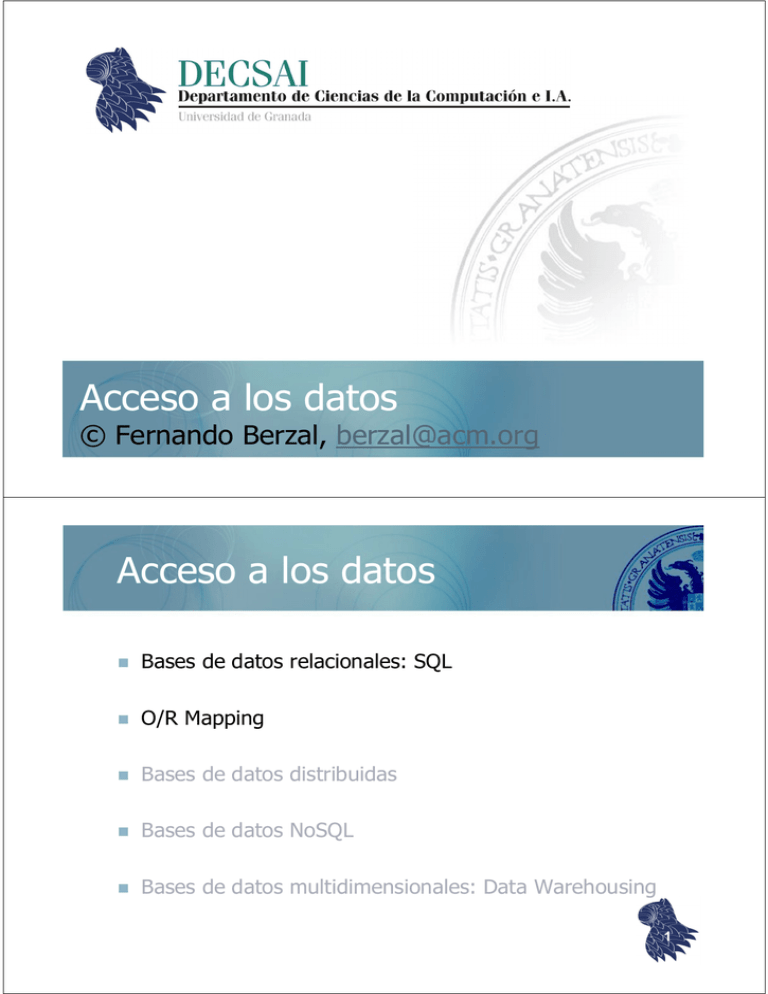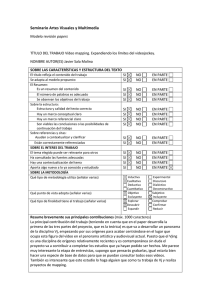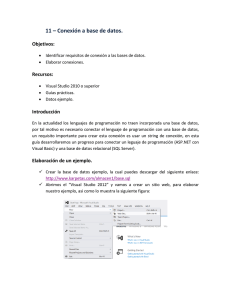Bases de datos relacionales y herramientas de O
Anuncio

Acceso a los datos
© Fernando Berzal, berzal@acm.org
Acceso a los datos
Bases de datos relacionales: SQL
O/R Mapping
Bases de datos distribuidas
Bases de datos NoSQL
Bases de datos multidimensionales: Data Warehousing
1
Acceso a los datos
Distintas formas de acceder a los datos almacenados en
una base de datos desde una aplicación:
Registros activos
(encapsulan las estructuras de datos externas).
Gateways
(clases auxiliares con operaciones CRUD).
O/R Mapping
[object-relational mapping]
2
Acceso a los datos
Registros activos
Objetos que encapsulan directamente las estructuras de
datos externas (p.ej. tuplas de una base de datos
relacional) e incorporan la lógica del dominio que les
corresponda, aparte de las operaciones necesarias para
obtener y guardar objetos en la base de datos.
3
Acceso a los datos
Gateways
Clases auxiliares que se corresponden con las entidades
presentes en la base de datos e implementan las
operaciones necesarias para manipular la base de datos
[CRUD: Create, Retrieve, Update & Delete].
El uso de gateways nos permite no mezclar la lógica
de la aplicación con el acceso a los datos externos.
4
Acceso a los datos
Gateways
Row Data Gateway
(1 gateway/tupla)
Table Data Gateway
(1 gateway/tabla)
5
Acceso a los datos
Gateways
Table Data Gateway
6
Acceso a los datos
Gateways
Row Data Gateway
7
Acceso a los datos
O/R Mapping.
Se establece una correspondencia entre el modelo
orientado a objetos del dominio y la representación de
los distintos objetos en una base de datos relacional.
En las dos alternativas anteriores, los objetos de la
aplicación han de ser conscientes de cómo se
representan en la base de datos.
En el caso del O/R mapping, los objetos pueden
ignorar la estructura de la base de datos y cómo se
realiza la comunicación con la base de datos.
8
Acceso a los datos
O/R Mapping.
Se establece una correspondencia entre el modelo
orientado a objetos del dominio y la representación de
los distintos objetos en una base de datos relacional.
9
Acceso a los datos
O/R Mapping.
Se establece una correspondencia entre el modelo
orientado a objetos del dominio y la representación de
los distintos objetos en una base de datos relacional.
La inversión de control característica de esta opción
independiza el modelo orientado a objetos del dominio
de la capa de acceso a los datos: se puede cambiar la
base de datos sin tener que tocar el modelo orientado
a objetos del dominio y viceversa.
Solución más flexible (facilita el desarrollo,
la depuración y la evolución de las aplicaciones).
10
Acceso a bases de datos
SQL
Structured Query Language
11
SQL Call-Level Interface [CLI]
ISO SQL/CLI (estándar SQL-92)
API [Application Programming Interface] para acceder
a una base de datos relacional utilizando sentencias SQL
desde el código de una aplicación:
ODBC [Open DataBase Connectivity] de Microsoft.
JDBC [Java DataBase Connectivity] en Java.
ADO.NET [ActiveX Data Objects] para .NET.
DB-API en Python.
…
12
SQL Call-Level Interface [CLI]
JDBC [Java DataBase Connectivity]
Drivers JDBC
JDBC-ODBC bridge
Native API driver
Middleware driver
Pure Java driver
13
SQL Call-Level Interface [CLI]
JDBC [Java DataBase Connectivity]
Principales clases
(paquete java.sql)
14
SQL Call-Level Interface [CLI]
JDBC [Java DataBase Connectivity]
Establecimiento de conexiones
try {
// 1. Cargamos el driver JDBC de nuestro DBMS (p.ej. Oracle)
Class.forName("oracle.jdbc.driver.OracleDriver");
// 2. Establecemos una conexión con la BD
Connection connection = DriverManager.getConnection(
"jdbc:oracle:thin:@localhost:1521:SID",
"usuario", "password");
…
} catch (ClassNotFoundException driverError) {
// Driver no encontrado
} catch (SQLException sqlError) {
// Error SQL (p.ej. usuario/clave incorrectas)
15
}
SQL Call-Level Interface [CLI]
JDBC [Java DataBase Connectivity]
Ejecución de sentencias SQL
Statement statement = connection.createStatement();
ResultSet set = statement.executeQuery("SELECT * FROM clients");
// Resultado de la consulta
while (set.next()) {
… set.getString("name"); …
… set.getString("address"); …
… set.getDate("birthdate"); …
… set.getBigDecimal("balance"); …
}
16
SQL Call-Level Interface [CLI]
JDBC [Java DataBase Connectivity]
Tipos de datos SQL
Tipo de dato SQL
Método JDBC
CHAR/VARCHAR
String getString()
DECIMAL/NUMERIC
java.math.BigDecimal getBigDecimal()
FLOAT/DOUBLE
double getDouble()
INTEGER
int getInt()
DATE
java.sql.Date getDate()
TIME
java.sql.Time getTime()
TIMESTAMP
java.sql.Timestamp getTimestamp()
BINARY
byte[] getBytes()
BLOB
java.io.InputStream getBinaryStream()
java.sql.Blob getBlob()
17
SQL Call-Level Interface [CLI]
JDBC [Java DataBase Connectivity]
Peligro: Inyección de código SQL
String sql = "select * from user where username='" + username
+ "' and password='" + password + "'";
stmt = conn.createStatement();
rs = stmt.executeQuery(sql);
if (rs.next()) {
out.println("Successfully logged in");
} else {
out.println(“Invalid username and/or password");
}
Entrada del usuario: username = admin' OR '1'='1
select * from user
where username='admin' OR '1'='1' and password=' '
18
SQL Call-Level Interface [CLI]
JDBC [Java DataBase Connectivity]
Para evitar ataques por inyección de código SQL…
PreparedStatement
PreparedStatement statement = connection.prepareStatement (
"UPDATE clients SET address = ? WHERE ID = ?");
statement.setString (1, "Nueva dirección");
statement.setInt (2, 123456 );
statement.execute();
// Resultado
… statement.getUpdateCount() …
// getResultSet() para consultas
19
SQL Call-Level Interface [CLI]
JDBC [Java DataBase Connectivity]
Pool de conexiones
20
SQL Call-Level Interface [CLI]
ADO.NET (plataforma .NET)
21
SQL Call-Level Interface [CLI]
ADO.NET (plataforma .NET)
Establecimiento de conexiones
string connectionString = "User ID=sa;Initial Catalog=MYDB;"
+ "Data Source=MYSERVER";
SqlConnection connection = new SqlConnection(connectionString);
Ejecución de consultas (usando DataSet)
SqlDataAdapter adapter = new SqlDataAdapter();
DataSet dataset = new DataSet();
string sqlQuery = "SELECT * FROM Customers";
adapter.SelectCommand = new SqlCommand(sqlQuery, connection);
connection.Open();
adapter.Fill(dataset);
connection.Close();
22
SQL Call-Level Interface [CLI]
ADO.NET (plataforma .NET)
Ejecución de consultas (usando DataReader)
string sqlQuery = "SELECT Name FROM Users";
SqlCommand sqlCommand = new SqlCommand(sqlQuery, connection);
connection.Open();
SqlDataReader reader = sqlCommand.ExecuteReader();
while (reader.Read()) {
… reader.GetString(0) …
}
myReader.Close();
connection.Close();
23
SQL Call-Level Interface [CLI]
ADO.NET (plataforma .NET)
Ejecución de sentencias SQL
string sqlInsert = "INSERT INTO Clients(Name) VALUES (@Name)";
SqlCommand sqlCommand = new SqlCommand(sqlInsert, connection);
SqlParameter param = sqlCommand.Parameters.Add (
new SqlParameter("@Name", SqlDbType.VarChar, 100));
param.Value = ...
connection.Open();
sqlCommand.ExecuteNonQuery();
connection.Close();
24
SQL Call-Level Interface [CLI]
SQLite (Android)
Esquema (local)
public final class FeedReaderContract {
public FeedReaderContract() {}
/* Inner class that defines the table contents */
public static abstract class FeedEntry implements BaseColumns {
public static final String TABLE_NAME = "entry";
public static final String COLUMN_NAME_ENTRY_ID = "entryid";
public static final String COLUMN_NAME_TITLE = "title";
public static final String COLUMN_NAME_SUBTITLE = "subtitle";
...
}
}
25
SQL Call-Level Interface [CLI]
SQLite (Android)
Base de datos (local): Creación
public class FeedReaderDbHelper extends SQLiteOpenHelper {
// If you change the database schema,
// you must increment the database version.
public static final int DATABASE_VERSION = 1;
public static final String DATABASE_NAME = "FeedReader.db";
public FeedReaderDbHelper(Context context) {
super(context, DATABASE_NAME, null, DATABASE_VERSION);
}
public void onCreate(SQLiteDatabase db) {
db.execSQL(SQL_CREATE_TABLE);
}
26
SQL Call-Level Interface [CLI]
SQLite (Android)
Base de datos (local): Actualizaciones
public void onUpgrade
(SQLiteDatabase db, int oldVersion, int newVersion) {
// Data cache, just discard the data and start over
db.execSQL(SQL_DROP_TABLE);
onCreate(db);
}
public void onDowngrade
(SQLiteDatabase db, int oldVersion, int newVersion) {
onUpgrade(db, oldVersion, newVersion);
}
}
27
SQL Call-Level Interface [CLI]
SQLite (Android)
Almacenamiento de datos
FeedReaderDbHelper mDbHelper
= new FeedReaderDbHelper(getContext());
SQLiteDatabase db
= mDbHelper.getWritableDatabase();
// Map of values, where column names are the keys
ContentValues values = new ContentValues();
values.put(FeedEntry.COLUMN_NAME_ENTRY_ID, id);
values.put(FeedEntry.COLUMN_NAME_TITLE, title);
values.put(FeedEntry.COLUMN_NAME_CONTENT, content);
// Insert the new row
long newRowId = db.insert(FeedEntry.TABLE_NAME,
FeedEntry.COLUMN_NAME_NULLABLE, values);
28
SQL Call-Level Interface [CLI]
SQLite (Android)
Consulta de datos
SQLiteDatabase db = mDbHelper.getReadableDatabase();
Cursor c = db.query(
FeedEntry.TABLE_NAME,
projection,
selection,
selectionArgs,
null,
null,
sortOrder );
//
//
//
//
//
//
//
//
.. or db.rawQuery(sqlStatement)
The table to query
The columns to return
The columns for the WHERE clause
The values for the WHERE clause
don't group the rows
don't filter by row groups
The sort order
cursor.moveToFirst();
long itemId = cursor.getLong(
cursor.getColumnIndexOrThrow(FeedEntry._ID));
29
SQL Call-Level Interface [CLI]
SQLite (Android)
Borrado y actualizaciones
// 'where' clause
String selection = FeedEntry.COLUMN_NAME_ENTRY_ID + " LIKE ?";
String[] selectionArgs = { String.valueOf(rowId) };
// SQL statement
db.delete(table_name, selection, selectionArgs);
// New values
ContentValues values = new ContentValues();
values.put(FeedEntry.COLUMN_NAME_TITLE, title);
// SQL statement
int count = db.update(FeedReaderDbHelper.FeedEntry.TABLE_NAME,30
values, selection, selectionArgs);
SQL Call-Level Interface [CLI]
SQLite (Android)
Utilizando SQL directamente
// SQL query
Cursor cursor = db.rawQuery (
"SELECT id, name FROM people WHERE id = ?",
new String[] {"1234"} );
// SQL statement
db.execSQL ( string );
//
//
//
//
NOTA: Google recomienda utilizar
- db.insert(String, String, ContentValues)
- db.update(String, ContentValues, String, String[])
- db.delete(String, String, String[])
31
SQL
LAMP stack
32
SQL
LAMP stack
33
O/R Mapping
The object-relational impedance mismatch
http://impedancemismatch.com/
34
O/R Mapping
35
O/R Mapping
Ejemplo: C#
Usando ADO.NET (CLI estándar para .NET):
String sql = "SELECT ... FROM clientes WHERE id = 10";
DbCommand cmd = new DbCommand(connection, sql);
Result res = cmd.Execute();
String name = res[0]["FIRST_NAME"];
Usando ORM:
Client client = repository.GetClient(10);
String name = client.getFirstName();
36
O/R Mapping
Foreign-key mapping
Relaciones muchos a uno y uno a muchos
37
O/R Mapping
Association table mapping
Relaciones muchos a muchos
38
O/R Mapping
Single table inheritance
Herencia & relaciones “es-un” (1/3)
39
O/R Mapping
Concrete table inheritance
Herencia & relaciones “es-un” (2/3)
40
O/R Mapping
Class table inheritance
Herencia & relaciones “es-un” (3/3)
41
O/R Mapping
Gestión de identidades
42
O/R Mapping
Lazy Load
Carga de los datos
Alternativas de implementación:
Inicialización (miembros null hasta que se accede a ellos).
Proxy (se carga el objeto real la primera vez que se llama).
Value holder (método getValue para acceder al objeto).
Ghost (objeto sin datos, se rellena de golpe).
43
O/R Mapping
Dependent mapping
Carga de los datos para entidades débiles
44
O/R Mapping
Herramientas de O/R Mapping
En vez de programar manualmente la correspondencia
entre objetos y tablas, se pueden utilizar metadatos para
especificar la correspondencia y automatizar el proceso.
45
O/R Mapping
Herramientas de O/R Mapping
Realización de consultas:
“Query objects”
46
O/R Mapping
Herramientas de O/R Mapping
Almacenamiento de datos:
“Repositories”
47
O/R Mapping
Herramientas de O/R Mapping
JDO [Java Data Objects]
JPA [Java Persistence API]: Lenguaje de consulta JPQL
DataNucleus (JDO & JPA), e.g. Google App Engine
Hibernate (Java, JPA) & Nhibernate (.NET)
iBATIS (Java, .NET, Ruby) → MyBATIS (Java)
48
Herramientas de O/R Mapping
DataNucleus (JDO & JPA)
1. Clases en Java
public class Product
{
String name;
String description;
double price;
…
}
public class Book extends Product
{
String author;
String isbn;
String publisher;
…
}
49
Herramientas de O/R Mapping
DataNucleus (JDO & JPA)
2a. Persistencia (anotaciones)
@PersistenceCapable
public class Product
{
String name;
String description;
double price;
…
}
@PersistenceCapable
public class Book extends Product
{
String author;
String isbn;
String publisher;
…
}
50
Herramientas de O/R Mapping
DataNucleus (JDO & JPA)
2b. Persistencia (XML)
<?xml version="1.0"?>
<!DOCTYPE orm PUBLIC "-//Sun Microsystems, Inc.//DTD Java Data Objects Metadata 2.0//EN"
"http://java.sun.com/dtd/orm_2_0.dtd">
<orm>
<package name="org.datanucleus.samples.jdo.tutorial">
<class name="Product" identity-type="datastore" table="JDO_PRODUCTS">
<inheritance strategy="new-table"/>
<field name="name">
<column name="PRODUCT_NAME" length="100" jdbc-type="VARCHAR"/></field>
<field name="description">
<column length="255" jdbc-type="VARCHAR"/></field></class>
<class name="Book" identity-type="datastore" table="JDO_BOOKS">
<inheritance strategy="new-table"/>
<field name="isbn">
<column length="20" jdbc-type="VARCHAR"/></field>
<field name="author">
<column length="40" jdbc-type="VARCHAR"/></field>
<field name="publisher">
<column length="40" jdbc-type="VARCHAR"/></field></class>
</package>
51
</orm>
Herramientas de O/R Mapping
DataNucleus (JDO & JPA)
3. Instrumentación de las clases: JDO “Enhancers”
Usando Ant
ant enhance
Usando Maven
mvn datanucleus:enhance
Manualmente
java –cp … org.datanucleus.enhancer.DataNucleusEnhancer *.java
52
Herramientas de O/R Mapping
DataNucleus (JDO & JPA)
4. Generación automática del esquema de la base de datos
Fichero de configuración (datanucleus.properties)
javax.jdo.PersistenceManagerFactoryClass=org.datanucleus.jdo.JDOPersistenceManagerFactory
javax.jdo.option.ConnectionDriverName=org.hsqldb.jdbcDriver
javax.jdo.option.ConnectionURL=jdbc:hsqldb:mem:nucleus1 javax.jdo.option.ConnectionUserName=sa
javax.jdo.option.ConnectionPassword= javax.jdo.option.Mapping=hsql
datanucleus.autoCreateSchema=true datanucleus.validateTables=false
datanucleus.validateConstraints=false
Usando Ant
ant createschema
Usando Maven
mvn datanucleus:schema-create
Manualmente
java –cp … org.datanucleus.store.rdbms.SchemaTool
-props datanucleus.properties -create *.java
53
Herramientas de O/R Mapping
DataNucleus (JDO & JPA)
5. Uso desde una aplicación: CREATE
PersistenceManagerFactory pmf =
JDOHelper.getPersistenceManagerFactory("datanucleus.properties");
PersistenceManager pm = pmf.getPersistenceManager();
Transaction tx=pm.currentTransaction();
try {
tx.begin();
Product product = new Product(“iPad", “Apple tablet", 649.99);
pm.makePersistent(product);
tx.commit();
} finally {
if (tx.isActive()) tx.rollback();
pm.close();
}
54
Herramientas de O/R Mapping
DataNucleus (JDO & JPA)
5. Uso desde una aplicación: READ
Transaction tx=pm.currentTransaction();
try {
tx.begin();
Extent e = pm.getExtent(Product.class, true);
Query q = pm.newQuery(e,"price < 1500.00");
q.setOrdering("price ascending");
Collection c = (Collection) q.execute();
for (Product p: c) { … }
tx.commit();
} finally {
if (tx.isActive()) tx.rollback();
pm.close();
}
55
Herramientas de O/R Mapping
DataNucleus (JDO & JPA)
5. Uso desde una aplicación: DELETE
Transaction tx = pm.currentTransaction();
try {
tx.begin();
...
pm.deletePersistent(product);
tx.commit();
} finally {
if (tx.isActive()) tx.rollback();
pm.close();
}
56
Herramientas de O/R Mapping
Hibernate
1. Clase en Java [POJO: Plain Old Java Object]
public class Employee
{
private int id;
private String firstName;
private String lastName;
private int level;
…
// Métodos get & set
…
}
57
Herramientas de O/R Mapping
Hibernate
2. Tabla en la base de datos relacional (p.ej. MySQL)
create table EMPLOYEE (
id INT NOT NULL auto_increment,
first_name VARCHAR(20) default NULL,
last_name VARCHAR(20) default NULL,
level INT default NULL,
PRIMARY KEY (id)
);
58
Herramientas de O/R Mapping
Hibernate
3. Fichero de configuración (Employee.hbm.xml)
<?xml version="1.0" encoding="utf-8"?>
<!DOCTYPE hibernate-mapping PUBLIC "-//Hibernate/Hibernate Mapping DTD//EN"
"http://www.hibernate.org/dtd/hibernate-mapping-3.0.dtd">
<hibernate-mapping>
<class name="Employee" table="EMPLOYEE">
<meta attribute="class-description">…</meta>
<id name="id" column="id" type="int">
<generator class="native"/>
</id>
<property name="firstName" column="first_name" type="string"/>
<property name="lastName" column="last_name" type="string"/>
<property name=“level" column=“level" type="int"/>
</class>
59
</hibernate-mapping>
Herramientas de O/R Mapping
Hibernate: CREATE
public int addEmployee (String fname, String lname, int level) {
Session session = sessionFactory.openSession();
Transaction tx = null;
Integer employeeID = null;
try{
tx = session.beginTransaction();
Employee employee = new Employee(fname, lname, level);
employeeID = (Integer) session.save(employee);
tx.commit();
} catch (HibernateException e) {
if (tx!=null) tx.rollback();
} finally {
session.close();
}
return employeeID;
60
}
Herramientas de O/R Mapping
Hibernate: READ
public List listEmployees () {
List employees;
Session session = factory.openSession();
Transaction tx = null;
try {
tx = session.beginTransaction();
employees = session.createQuery("FROM Employee").list();
tx.commit();
} catch (HibernateException e) {
if (tx!=null) tx.rollback();
} finally {
session.close();
}
return employees:
}
// for (Employee employee: employees) …
61
Herramientas de O/R Mapping
Hibernate: UPDATE
public void updateEmployee (int EmployeeID, int level) {
Session session = factory.openSession();
Transaction tx = null;
try {
tx = session.beginTransaction();
Employee employee = (Employee)session.get(Employee.class, EmployeeID);
employee.setLevel ( level );
session.update(employee);
tx.commit();
} catch (HibernateException e) {
if (tx!=null) tx.rollback();
} finally {
session.close();
}
}
62
Herramientas de O/R Mapping
Hibernate: DELETE
public void deleteEmployee (int EmployeeID) {
Session session = factory.openSession();
Transaction tx = null;
try {
tx = session.beginTransaction();
Employee employee = (Employee)session.get(Employee.class, EmployeeID);
session.delete(employee);
tx.commit();
} catch (HibernateException e) {
if (tx!=null) tx.rollback();
} finally {
session.close();
}
}
63
Herramientas de O/R Mapping
iBATIS → MyBatis
Acopla objetos en Java
con sentencias SQL
o llamadas a procedimientos almacenados
Opción A: Usando anotaciones
public interface BlogMapper {
@Select("select * from Blog where id = #{id}")
Blog selectBlog(int id);
}
BlogMapper mapper = session.getMapper(BlogMapper.class);
Blog blog = mapper.selectBlog(101);
64
Herramientas de O/R Mapping
iBATIS → MyBatis
Acopla objetos en Java
con sentencias SQL
o llamadas a procedimientos almacenados
Opción B: Usando ficheros XML
<?xml version="1.0" encoding="UTF-8" ?>
<!DOCTYPE mapper PUBLIC "-//mybatis.org//DTD Mapper 3.0//EN" "http://mybatis.org/dtd/mybatis-3-mapper.dtd">
<mapper namespace="BlogMapper">
<select id="selectBlog" parameterType="int" resultType="Blog">
select * from Blog where id = #{id}
</select>
</mapper>
Blog blog = session.selectOne("BlogMapper.selectBlog", 101); 65
Herramientas de O/R Mapping
JPA [Java Persistence API]
Clases anotadas
@Entity
@Entity
public class Book {
@Id
private Integer id;
private String title;
private String isbn;
@ManyToOne
private Publisher publisher;
@ManyToMany
private List<Author> authors;
}
public class Publisher {
@Id
private Integer id;
private String name;
private String address;
@OneToMany(mappedBy = "publisher")
private List<Book> books;
}
@Entity
public class Author {
@Id
private Integer id;
private String firstName;
private String lastName;
@ManyToMany
private List<Book> books;
}
66
Herramientas de O/R Mapping
JPA [Java Persistence API]
Lenguaje de consulta JPQL
import javax.persistence.EntityManager;
import javax.persistence.Query;
…
public List<Author> getAuthorsByLastName(String lastName)
{
String queryString = "SELECT a FROM Author a" +
" WHERE a.lastName IS NULL" +
" OR LOWER(a.lastName)=LOWER(:lastName)";
Query query = getEntityManager().createQuery(queryString);
query.setParameter("lastName", lastName);
return query.getResultList();
67
}
Bibliografía recomendada
Martin Fowler:
Patterns of Enterprise
Application Architecture
Addison-Wesley, 2003.
ISBN 0321127420
http://martinfowler.com/eaaCatalog/
68



